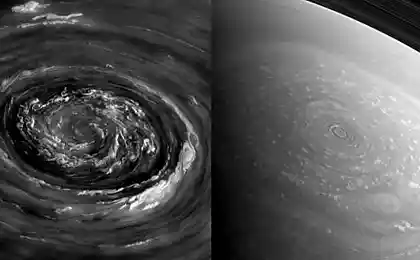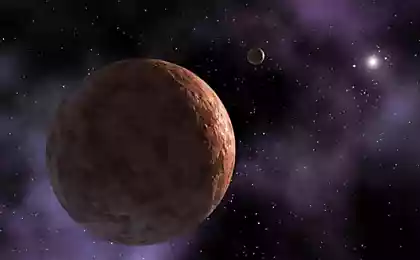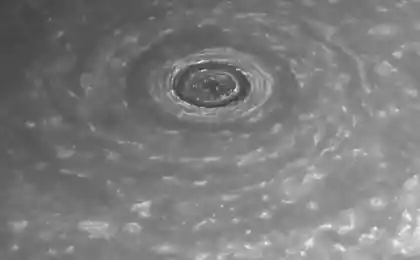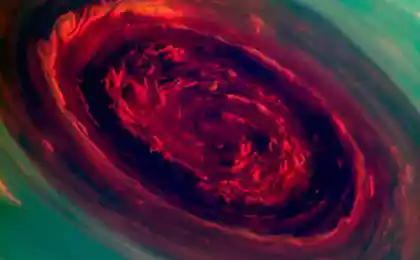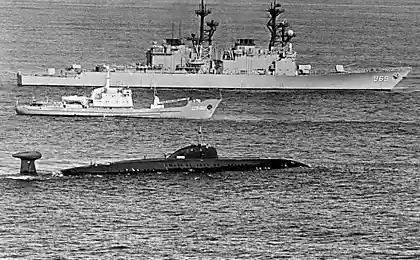588
The gigantic storm on Saturn.
Interplanetary probe Cassini managed to get clear pictures of the raging storm on the planet Saturn, a giant ring encircling the planet. This was reported by JPL NASA, located in Pasadena (California).
The storm of unprecedented scale since 1990 rages on the gas giant for several months. In recent years, it is a powerful atmospheric formation increased and now covers an area of area of 4 billion square meters. km.
This is about one-tenth of the entire surface of Saturn, which is eighty times the size of Earth's surface (and thus, the area of the storm raging in the gas giant, is eight times larger than that of the Earth's surface), ITAR-TASS reported.
The first data about the formation of thunderstorms December 5 last year, received and sent to Earth onboard instruments automatic interplanetary station NASA Cassini, in orbit of Saturn.
According to the testimony of scientific instruments, lightning, shining over the planet, at the peak of activity was observed more often ten times per second, so that even devices NASA can not catch a break in between.
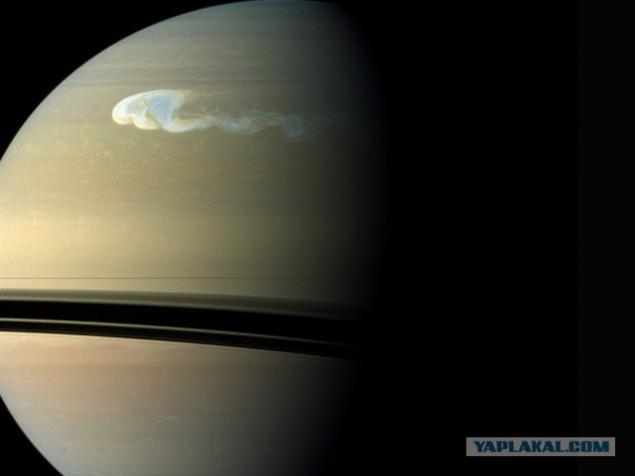
The extent of the storm about 500 times larger than the powerful effects of this kind, Cassini recorded in 2009-2010.
The information transmitted to Earth from the station, have enabled scientists to mount a small audio file posted on the site NASA. "Sounds" Saturnian thunderstorms were based on data on the frequency and duration of radio signals that occur when a lightning in the atmosphere of the planet. Most of all they resemble electrostatic interference that is often heard in the storm and earth.
Observations have also shown that thunderstorms can occur in both hemispheres of Saturn. Now the storm is raging in the northern hemisphere that have been linked with the change of seasons. Earlier Cassini instruments recorded a thunderstorm in the southern hemisphere of the planet.
"The weather on Saturn can remain quiet for many years, but then rapidly formed such storms," - said study author Andrew Ingersoll of the California Institute of Technology in Pasadena.
Spacecraft orbiting or flying past the planet, has never witnessed such a powerful storm on Saturn.
The phenomenon of similar magnitude recorded in 1990, the space telescope NASA Hubble, orbiting the Earth.
Cassini was put into space in 1997 and reached Saturn in 2004. Originally, the station is to complete the mission in 2008. However, the timing of the expedition was extended twice - first for 27 months, then to 2017.
newsru.com

Source:
The storm of unprecedented scale since 1990 rages on the gas giant for several months. In recent years, it is a powerful atmospheric formation increased and now covers an area of area of 4 billion square meters. km.
This is about one-tenth of the entire surface of Saturn, which is eighty times the size of Earth's surface (and thus, the area of the storm raging in the gas giant, is eight times larger than that of the Earth's surface), ITAR-TASS reported.
The first data about the formation of thunderstorms December 5 last year, received and sent to Earth onboard instruments automatic interplanetary station NASA Cassini, in orbit of Saturn.
According to the testimony of scientific instruments, lightning, shining over the planet, at the peak of activity was observed more often ten times per second, so that even devices NASA can not catch a break in between.

The extent of the storm about 500 times larger than the powerful effects of this kind, Cassini recorded in 2009-2010.
The information transmitted to Earth from the station, have enabled scientists to mount a small audio file posted on the site NASA. "Sounds" Saturnian thunderstorms were based on data on the frequency and duration of radio signals that occur when a lightning in the atmosphere of the planet. Most of all they resemble electrostatic interference that is often heard in the storm and earth.
Observations have also shown that thunderstorms can occur in both hemispheres of Saturn. Now the storm is raging in the northern hemisphere that have been linked with the change of seasons. Earlier Cassini instruments recorded a thunderstorm in the southern hemisphere of the planet.
"The weather on Saturn can remain quiet for many years, but then rapidly formed such storms," - said study author Andrew Ingersoll of the California Institute of Technology in Pasadena.
Spacecraft orbiting or flying past the planet, has never witnessed such a powerful storm on Saturn.
The phenomenon of similar magnitude recorded in 1990, the space telescope NASA Hubble, orbiting the Earth.
Cassini was put into space in 1997 and reached Saturn in 2004. Originally, the station is to complete the mission in 2008. However, the timing of the expedition was extended twice - first for 27 months, then to 2017.
newsru.com

Source:





